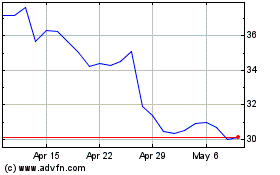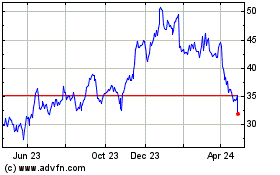Intel Raises Its Outlook -- WSJ
September 17 2016 - 3:02AM
Dow Jones News
By Don Clark and Anne Steele
Intel Corp. boosted its outlook for the third quarter on Friday,
the latest sign that demand for some categories of personal
computers has improved.
Stronger buying activity seems concentrated in high-end laptops
and gaming PCs, analysts and industry executives said, while demand
for entry-level PCs remains weak.
Intel, which supplies microprocessor chips used in close to 90%
of all PCs, said it now expects third-quarter revenue of $15.6
billion, plus or minus $300 million, up from a previous range of
$14.9 billion, plus or minus $500 million. The company also boosted
its gross margin forecast by two percentage points.
Even at the bottom of its range, the new revenue forecast
exceeds last year's third-quarter total of $14.47 billion.
Intel attributed the improved revenue primarily to moves by
hardware makers to replenish their inventories of finished PCs and
components. "The company is also seeing some signs of improving PC
demand," Intel said in a press release.
The company didn't elaborate. But Stephen Baker, an analyst who
tracks sales in U.S. retail and distribution channels for NPD
Group, said customers have lately have been buying more premium
laptops, as well as those that convert between clamshell and tablet
mode, and hardware targeted toward gaming.
Such purchases tend to involve faster Intel chips with higher
price tags. "I think what they are probably seeing is a lot of
shifting from more entry-level processors to more premium
processors," Mr. Baker said.
One company feeling a substantial upswing in sales is Falcon
Northwest, a boutique Oregon-based maker of gaming PCs typically
priced at $3,000 to $5,000. Kelt Reeves, its president, said sales
in the quarter ended in August rose 49% -- the strongest quarterly
gain since the company was founded in 1992.
Falcon's PCs use Intel microprocessors. But Mr. Reeves
attributed recent demand to the arrival of new graphics chips from
Nvidia Corp., which help improve the visual effects in game
software, as well as the arrival of new virtual-reality headsets
that need to connect to powerful PCs for the most vivid
experiences.
Mr. Baker of NPD agreed that Nvidia technology, rather than
Intel's latest microprocessors, is likely spurring consumer
purchases.
"Intel's PC growth trajectory remains challenging with new
products having little to no impact on demand," said Stacy Rasgon,
an analyst with Sanford C. Bernstein, in a research note.
PC shipments continued their steady decline of the past two
years in the second quarter, research firms International Data
Corp. and Gartner Inc. said in July, but the declines were less
severe than in recent periods. Intel said that month that
second-quarter revenue in its "client" business, which includes PC
chips, declined 3% from the year-earlier period.
Brian Krzanich, Intel's chief executive since 2013, has tried to
push the company into markets beyond PCs such as connected cars,
wearable devices and devices used to handle retail transactions.
The company has largely failed to place its chips in many
smartphones, but so-called teardown reports on Friday from research
firms that disassemble new devices showed that Intel technology has
been included in some new Apple iPhone 7s.
Intel is set to report its third-quarter results on Oct. 18. Its
shares rose 3.1% to $37.69 in New York trading on Friday.
Write to Don Clark at don.clark@wsj.com and Anne Steele at
Anne.Steele@wsj.com
(END) Dow Jones Newswires
September 17, 2016 02:47 ET (06:47 GMT)
Copyright (c) 2016 Dow Jones & Company, Inc.
Intel (NASDAQ:INTC)
Historical Stock Chart
From Mar 2024 to Apr 2024

Intel (NASDAQ:INTC)
Historical Stock Chart
From Apr 2023 to Apr 2024
